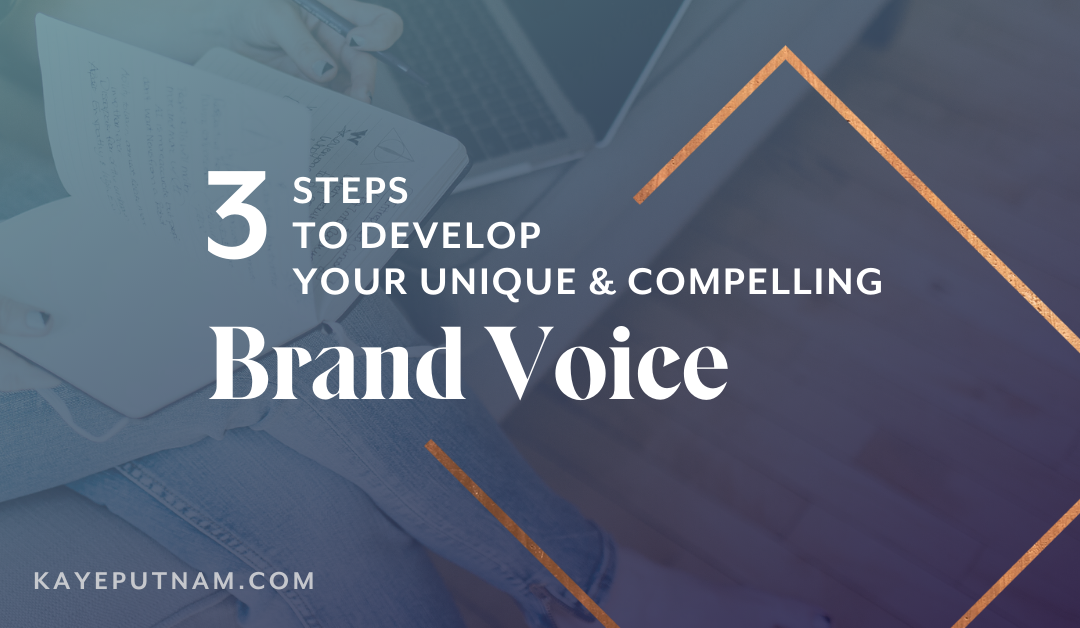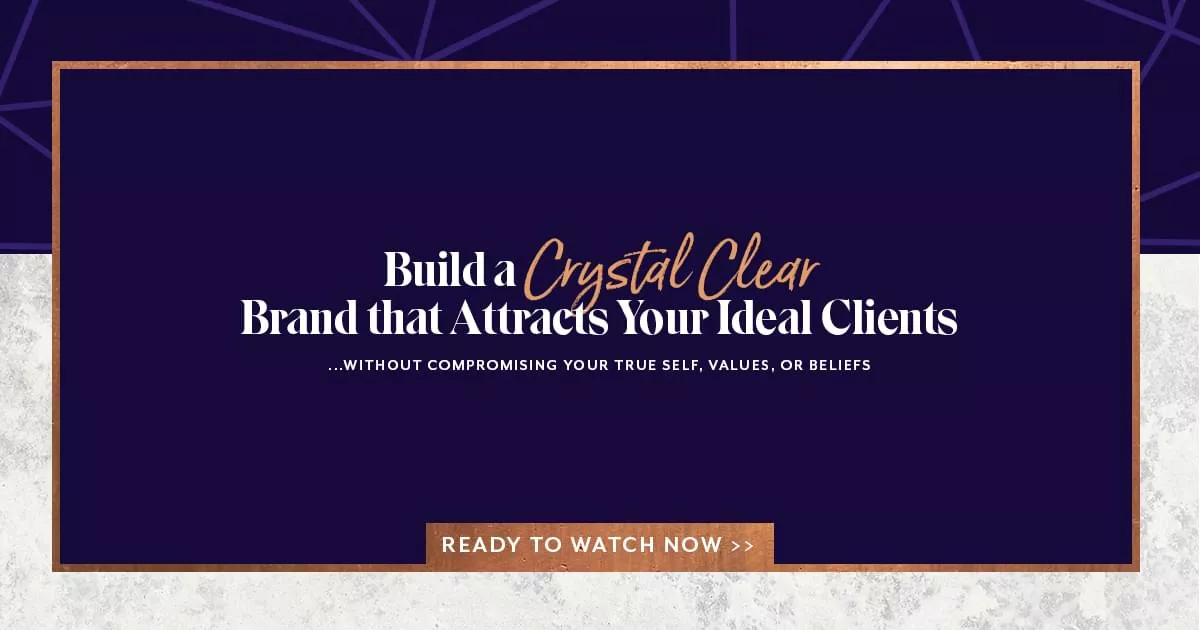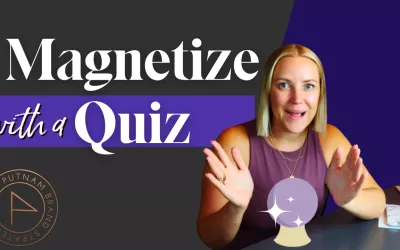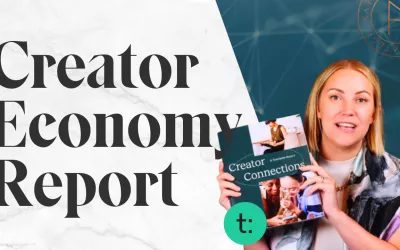Do you ever look longingly at a few reeeeeeeaaaaallllllly covetable Instagram accounts, websites, blogs? Or any content from brands (big or small!) that are just totally killin’ it…?
When you see one, you think something like…
She is so unapologetically “her.”
I feel like I know her.
I know exactly what she’s about.
As soon as I read a few words, I *know* it’s her.
(No matter where she shows up, you can almost tell it’s her before you even see an account name – or a color or a font.)
If you examine those brands you admire, you’ll see they are actually choosing their words… design details… EVERYTHING… really carefully. The style that they format their text in. The particular way a few words are strung together. Or the slang that they do or don’t use… it’s all quite intentional.
And no matter how many people (her team!) are responsible for what’s showing up at each touchpoint, the details are consistent – which makes her memorable.
➡️ Here’s the thing… You can have that, too. ⬅️
That “je nais se quois” that makes her so recognizable? That makes you trust and like her? It’s NOT reserved exclusively for the few. It’s within your reach, too.
Here’s the secret scoop on the “how:” 🤫🤫🤫
If you want to cultivate a brand voice that attracts your ideal clients (and even repels those you don’t want to work with!), you MUST hit these two marks:
✅ You’ll need to be memorable.
✅ You’ll need to be relatable.
Because I’ve been behind the scenes with hundreds of brands, I KNOW how this is done. And, because I think you are amazing, Dear Reader, today I’m sharing the THREE STEPS you’ll need to take to develop your compelling brand voice.
As usual, you can watch 🎥 🎥 🎥 today’s content directly below. And, for more detail, you can continue on and read the nitty-gritties…
Ready? Okay, let’s talk specifics.
Step 1: Define your brand’s personality.
The first step for finding your compelling brand voice is to define your brand’s personality.
In everyday life, “having personality” is a desirable and useful thing – and necessary for being memorable and relatable, right?
Think about it. As humans, we love someone who “has personality.”
If a baby is particularly interactive, smiley, or engaged, we say she “has so much personality!” (Cooochie-coooochie-coo.) 👶🏽
If your Uncle Larry is your favorite – and everyone clamors to sit next to him at Thanksgiving – it might be because he has “such a great personality.” (Oh those stories of when he was in college in New Orleans! Crazy!)
We remember that baby, and we can relate to the emotions she’s displaying. We remember Uncle Larry, and can’t wait to hear what he’s up to now.
The same is true for your brand.
So, I want to encourage you to think about your brand as a person. Think of it like a well-defined character… Yep, just like in a great movie or a page-turner of a book. (Or at your Thanksgiving table!)
How does this character show up? How does he relate to people? What are his opinions, likes, and dislikes? How would that person talk to your ideal client?
Right about now you might be thinking… “Cool, Kaye. I get it. I need to give my brand personality. But what type of personality? There are sort of a LOT of types of personalities. And how would I choose and use them?”
I’ve got you! Here are some highly effective ways to do just that:
To define personality, choose brand archetypes.
This is one of my favorite tools for defining a brand’s personality. I encourage my students and clients to choose both primary and secondary types.
A little background… The brand archetypes are universally recognized figures (like the Magician, the Hero, the Sage, the Girl or the Guy Next Door… there are 12 types in total!) They stand for certain basic human motivations and emotions. Humans want to connect to other humans – even and especially when they are shopping and buying. The archetypes help us connect emotionally to our ideal customers.
Discovering and choosing archetypes helps narrow your focus. It gives you an effective and enduring framework around which to craft your brand. It presents you with a veritable cornucopia of ideas and inspiration that are all on brand for you – and not for Joe Shmoe down the street.
You can learn more about the 12 archetypes here, and take my Brand Personality Quiz to determine yours! Then, convey that personality everywhere – to be memorable and relatable!
To define personality, tell your brand’s stories.
The stories that you tell go SUCH a loooooooong way in communicating your brand personality – and cementing it in the minds and hearts of your audience.
As a human race, we have a long anthropological history of bonding over mutual experiences – and it’s ingrained in us to share those experiences with each other. When exposed to second-hand information via a good story, the human brain behaves very similarly as to when it experiences something first-hand. Studies (like Dr. Paul Zak’s study reviewed in this video) have proven that stories trigger the release of dopamine, oxytocin, and cortisol – just as if we were the subjects of those stories, and they were happening to us.
Meanwhile, it’s also proven humans remember stories longer than facts. Cognitive scientists have confirmed that “experiences that aren’t framed in story form suffer loss in memory… Framing the logical in narrative makes it easier to remember.” (Source: Jesseman, Deborah J. “Writing and Storytelling.” 2017.)
Case in point here: Pneumonic devices are like little stories… Remember, “My Very Educated Mother Just Served Us Nine Pickles?”
(You may now be totally relating… or you may think I’m crazy. 🤣 Why is Kaye talking about pickles…? But I was taught this to remember the order of the planets in our solar system. And there’s probably about a 78% chance you were, too, so I’m taking the risk.)
Anywhoooooo…. The lessons? Develop your signature origin story, brand value stories, teaching stories – and maybe a few more of the six types of brand stories that I reviewed in this article. Then, leverage the bejesus out of them to be more relatable and memorable – and to ensure your messages will be compelling!
To define personality, weave human elements into your brand.
Carl Jung wrote this [in “The Development of Personality,” 1932], and it has always stuck with me:
“Personality is the supreme realization of the innate idiosyncrasy of a living being… affirmation of all that constitutes the individual… ”
Along the way in my entrepreneur journey, I learned that potential customers were remembering me for the “little” details – the idiosyncrasies. Sometimes, they remember them even more readily than the fact that I’m a brand strategist – or the “results” I help clients get!
What do I mean by “idiosyncrasies?” Well… I noticed on a few occasions that someone referred to me as “the brand quiz lady that lives in Italy.” (My husband’s work took my family there for three amazing years!)
And I’ve received more than one message bringing my attention to a fabulous hat I should own. (Keep ‘em coming! 😂) I often talk about my love for hats – and my hat wardrobe appears in many of my brand photos. People remember that.
My other obsessions… with Game of Thrones? Gelato? Crossfit? Yup… all almost completely unrelated to branding… but all things that trigger people to remember me.
Boy, am I glad that I don’t just keep those details of my life to myself!
So don’t be afraid to add in some fun and unexpected details – about yourself – into your brand. Adding in some of these human likes, dislikes and points of view are going to make your brand voice shine. This is one of the best – and most fun! – ways to be more memorable and relatable.
(TL;DR? — Stay weird!) 🤪
Okay, on to STEP 2 in this 3-step equation…
Pin this article to reference later! 📌

Pin this article to reference later! 📌
Step 2: Find, curate, and set the standards for your brand voice.
Once you know yourself and your brand personality is somewhat established, it’s time for the second step of this process. Your ongoing* assignment is to curate examples – and to write (and refine) brand standards.
These brand standards will serve to ensure your brand personality is communicated in all the places you’re showing up.
Remember those covetable brands I mentioned at the beginning? Instagram accounts, websites, blogs, etc. with SUPER-distinct brand voices?
To get that degree of consistency, it’s up to you to curate examples of how your brand behaves in the wild – and stick to them! Here’s how I recommend you do this:
To set the standards for your brand, develop a guide for you – and your team – follow.
A brand standards guide or document is essentially a collection of two things — what your brand (that person or character you’ve defined above!) WOULD DO and what your brand WOULDN’T DO.
The key to a brand standards guide that is useful – and to the compelling brand voice that it results in? It’s to get very specific.
To demonstrate the nitty-gritty level of specificity I’m talking about here… here are just a few examples of questions to ask and answers to document.
- What’s the style of your text? Are you an all caps, all excited type of brand? Or maybe you’re a defy the rules, unconventional, all lowercase type of brand? Or maybe just the traditional title case type of brand?
- What slang do you do or do not use, and are you going to swear in your brand?
- How will you address your audience – in an email, for example? Would you ever open with “To Whom It May Concern…?” Or, would you say, “Hello, Kaye?” Or maybe you just like to say, “Hey there!”
- How will your words are going to be styled on the screen or on the page when you’re talking to your ideal clients? Do you use a lot of italics?… Rarely use exclamation points?… Use a ton of ellipses (and parenthetical phrases), like I do?… 🤣🤣🤣
(These three are just examples, and these are all about words… but your brand standards will address words – PLUS all other aspects of your brand. If you want to go deeper, you can see some examples of brand standards guides by viewing:
- Brand Books – the tangible product my students create in the self-guided Brand New Brand course.)
To set the standards that ensure your brand is memorable, aim to “own” words.
This strategy is so powerful 💪🏼, that I want to call it out separately here. Many memorable and impactful brands have certain phrases or ideas that they sort of “own.”
Now, this doesn’t necessarily mean that they have intellectual property “ownership” (like a patent or a copyright – although they could…)
What is does mean is this: When your ideal, indoctrinated client hears / reads that phrase – their brains almost immediately conjure up your brand.
This might be a product name. Here’s an example:
The term “B-School” is short for business school – and the general public likely thinks about an MBA, or certain universities that offer well-known MBA programs.
BUT for anyone who is an ideal client for Marie Forleo (typically aspiring online entrepreneurs) AND has been in her orbit for any time – B-School is synonymous with Marie.
It might be a word that you use to describe the outcome that your ideal clients get. Here’s an example:
One of my brand’s “goals” (if you will 🙂) is to trigger my ideal clients to think of me when they hear “brand clarity.” I use the word clarity on sales pages, in product and service names, and even in my discovery call offer (It’s a “Clarity call.”)
Another example? I don’t know about you, but I can’t hear someone say something or someone is “in good hands…” without hearing Dennis Haysbert’s velvety, reassuring voice saying the words. And, of course, I think of Allstate Insurance. Every. Darn. Time.
Essentially, there should be a very short list of words that – when encountered by your ideal client, cause them to think of your brand. Decide what those are in advance – so that you can use them throughout your copy and content.
Step 3: Stay in action! (It’s an iterative process.)
Remember up in Step 2, in the first line, when I told you your assignment to curate brand standards was “ongoing?” (I even bolded AND italicized it! Whoa! 😂 )
Yep… I really meant it. Ongoing.
So, the third step in this process of developing a killer brand voice? It’s to actually get to work – and STAY IN ACTION! 🏃🏻♀️🏃🏻♀️🏃🏻♀️
Branding is an iterative process. So, even after you create your brand standards guide, you’re not done. The guide is, in fact, a living and breathing document. It will always be evolving and getting better as you add to it. It will always be honing in – more and more effectively – on that compelling brand voice you’re developing.
And, here’s the incredibly powerful thing about this constant state of upgrading and tweaking… (Wait for it… It’s so so so soooo good. 😌)
It means you can never lose.
Let me explain…
Imagine this: You hire a copywriter to create something for you – maybe a sales page, a website “about page,” or something equally important to your brand.
And they completely flop. They just don’t get you. Their words don’t sound like you at all.
Womp-womp.
This *could* be a very discouraging experience. But I’d like you to see it as a great opportunity… The perfect impetus to improve upon the brand standards you’ve documented.
Here’s how to actually GROW from this experience:
Comb through the work you received, and figure out *exactly* what is there that is NOT right.
- What are the words that they’re using that don’t sound true to you?
- What is the styling or punctuation that they’re using that’s not fitting?
- What stories are they telling that aren’t on brand for you?
Conversely, try to also flip each “negative” and springboard your thought process to the “positive.” What WOULD have been a better choice?
- What words would have been more “you?”
- What styling or punctuation would be a better fit?
- How can those stories be tweaked – or replaced – to convey the values and opinions you DO have?
Add these – BOTH the “DON’Ts” and the “DOs” – to the written standards you’re curating. And, BAM! You’re improving. You’re progressing. You’re gaining clarity. You’re winning.
(*Don’t leave the “DON’Ts out of your written standards… they are often even more useful in practical application than the “Do’s.”)
And, in terms of staying in action – keep writing. Keep collecting and curating stories that fit your brand to a T. Keep putting your opinions and ideas to paper (so to speak! 💻 ).
Keep in action – so that you can find your voice through the acts of publishing and seeing what resonates – with you and with your ideal clients. The more that you know, the more that you write, the more that you publish… the more you’ll collect “data” about who you actually are – and what you sound like.
So, Genius… Cultivating a compelling and unique brand voice? One that that attracts your ideal clients and makes you memorable and relatable in their minds? It’s not easy or automatic – but it can be simplified and accelerated if you follow the three steps I’ve outlined here.
So, devote yourself to: 1) defining your brand personality… 2) finding, curating, and setting the standards for your brand voice… and 3) staying in constant action and reinvention as you go!
A clear brand makes EVERYTHING easier, so it’s worth it.
You’re worth it, and the world needs your genius!
Are you craving more clarity for your brand?
And ready to follow a PROVEN framework for developing that winning brand voice? Brilliant! Then click here to sign up for this FREE masterclass I created for you: *How To Build A Crystal Clear Brand That Attracts Your Ideal Clients.*
➡️ (Yes! You read that right. It’s totally free!) ⬅️
In the training, we’ll throw out the old ideal client “avatars” and build a stronger brand and a more compelling voice – with less work. And you’ll learn to leverage it ALL to attract clients willing to pay 2x or 3x more – and then rave about the experience.
Ready? >>> Click right here to join me in the free masterclass!





